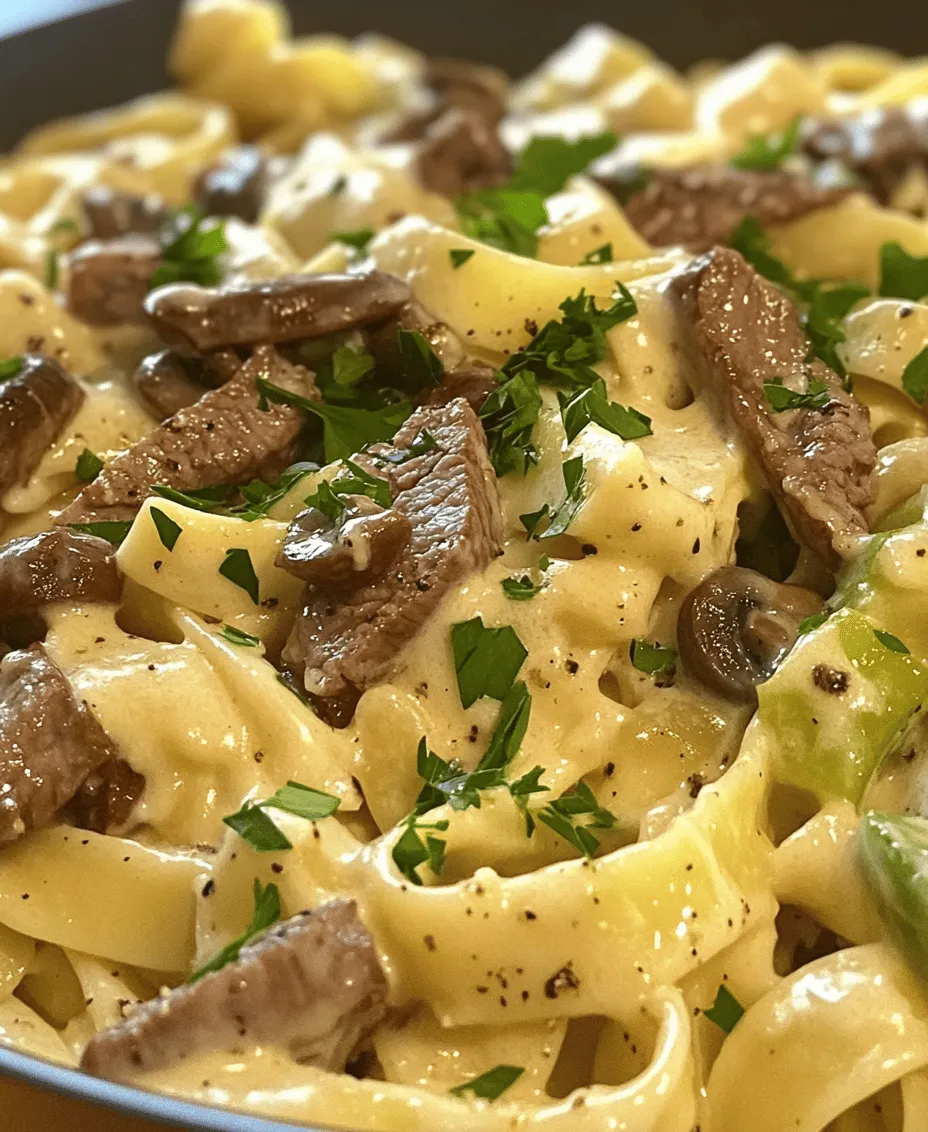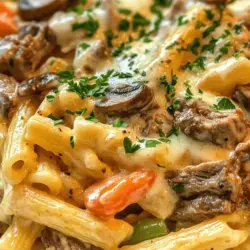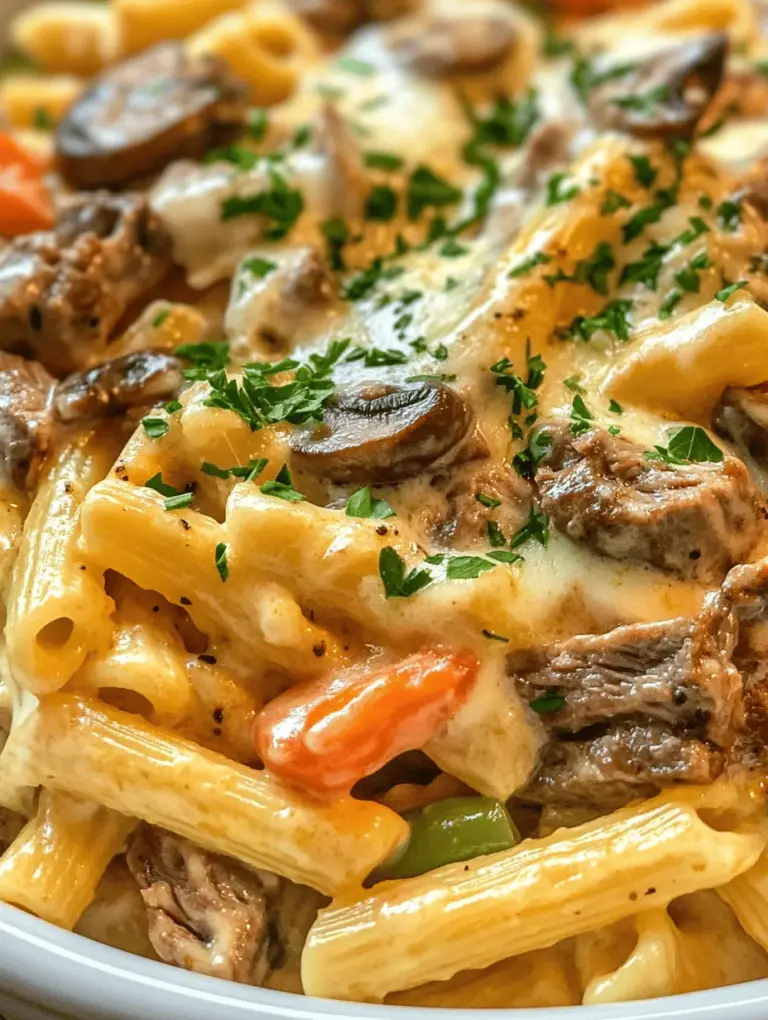Introduction
Delve into the delicious world of comfort food with our Philly Cheese Steak Pasta recipe. This dish beautifully combines the classic flavors of a Philly cheesesteak with the satisfying texture of pasta, creating a meal that’s perfect for family dinners or casual gatherings. Imagine the rich, savory taste of thinly sliced steak, sautéed onions, and melted cheese enveloped in luscious pasta, all coming together to create a symphony of flavors that tantalizes the taste buds.
In this article, we will walk you through the process of making this creamy, cheesy delight, from selecting the right ingredients to serving it up in style. Whether you’re a seasoned cook or a kitchen novice, this recipe is designed to help you create an unforgettable dining experience that will have your family and friends asking for seconds.
Understanding the Origins of Philly Cheese Steak
Exploring the Cultural Significance
The Philly cheesesteak is more than just a sandwich; it’s a culinary icon that has roots deeply embedded in Philadelphia’s rich food culture. Originating in the early 20th century, this beloved dish was created by Pat Olivieri, a hot dog vendor who decided to grill some steak on his cart one day. The combination of sautéed beef and onions caught the attention of passersby, and soon, the Philly cheesesteak was born. Over the years, this humble sandwich evolved from street food to an institution, with countless variations sprouting up across the country.
The cheesesteak’s popularity transcends regional boundaries, leading to creative interpretations that have made their way into countless kitchens. Among these adaptations is the delightful Philly Cheese Steak Pasta, which captures the essence of the original dish but incorporates pasta for an added layer of comfort. This innovative twist pays homage to the classic while inviting a new generation of food lovers to enjoy its rich flavors in a different form.
Unraveling the History of Philly Cheese Steak and its Evolution into a Pasta Dish
As the cheesesteak gained popularity, it became a staple in diners and restaurants, each establishment proudly claiming its own unique recipe. While traditionalists argue about the best cheese—be it Cheez Whiz, provolone, or American—the dish continued to evolve. Chefs and home cooks alike began experimenting with the classic ingredients, incorporating them into other dishes to create new culinary experiences.
The transformation into pasta is a natural progression, as pasta serves as a versatile base that can absorb and enhance flavors. By combining the beloved components of a cheesesteak with pasta, we create a hearty, filling dish that maintains the essence of the original while adding a new dimension. This recipe is not just a meal; it is a celebration of the rich culinary heritage of Philadelphia and an invitation to enjoy its flavors in a comforting new way.
Highlighting Its Popularity and Variations Across the United States
Today, Philly cheese steak pasta can be found on menus across the United States, often showcasing regional ingredients and personal touches. From spicy variations featuring jalapeños to creamy versions with garlic and herbs, this dish has taken on many forms. Each rendition highlights the creativity of cooks who are eager to push culinary boundaries while honoring the beloved cheesesteak.
The versatility of this recipe allows it to fit into various dining occasions, whether it’s a weeknight dinner or a casual gathering with friends. As its popularity continues to grow, so does the opportunity for home cooks to create their own versions, adding personal flair to the classic dish.
Ingredients Breakdown
Essential Components of Philly Cheese Steak Pasta
To create a truly delectable Philly Cheese Steak Pasta, it’s vital to select high-quality ingredients that will enhance the flavors and textures of the dish. Let’s break down the essential components:
1. Pasta: The foundation of the dish. While traditional recipes might use fettuccine or penne, the type of pasta you choose can significantly impact the dish. Fettuccine’s wide, flat surface allows it to hold onto the creamy sauce, while penne offers bite-sized pieces that are perfect for scooping up flavorful ingredients.
2. Steak: The star of the show. Flank steak or sirloin are great options for this recipe, as they are flavorful and tender when cooked properly. Thinly slicing the steak against the grain ensures that it remains juicy and easy to chew.
3. Onions: Sweet onions are typically used to add depth and sweetness. Sautéing them until they are caramelized brings out their natural sugars, enhancing the overall flavor profile of the dish.
4. Bell Peppers: While not always included in traditional cheesesteaks, bell peppers add a delightful crunch and sweetness to the pasta. Their vibrant colors also contribute to the dish’s visual appeal.
5. Cheese: The ultimate comfort food element. Cheddar, provolone, or even the iconic Cheez Whiz can be used to create a creamy, cheesy sauce that binds all the ingredients together. The choice of cheese can vary based on personal preference, but using a combination of cheeses can yield a richer flavor.
6. Cream: Heavy cream is essential for creating the luscious, creamy sauce that coats the pasta and steak. It adds richness and helps to unite all the flavors.
7. Seasonings: Simple seasonings such as salt, pepper, garlic powder, and Italian seasoning can elevate the dish. Fresh herbs like parsley can be used as a garnish for a pop of color and freshness.
A Detailed Look at Each Ingredient and its Role in Enhancing Flavor and Texture
– Pasta: The right pasta not only offers texture but also acts as a vehicle for the sauce and other ingredients. Choosing a type that complements the creamy sauce is crucial for overall success.
– Steak: The choice of steak is fundamental to achieving that authentic cheesesteak taste. Flank steak and sirloin are both tender and flavorful, making them ideal for this dish.
– Onions and Bell Peppers: The sautéed vegetables add sweetness and a slight crunch, contributing to the dish’s overall texture. Their caramelization deepens the flavor, making every bite satisfying.
– Cheese: A blend of cheeses can create a complex flavor profile. Cheddar adds sharpness, while provolone brings a milder, creamier texture, resulting in a well-balanced sauce.
– Cream: This ingredient is what makes the dish indulgent. It creates a velvety sauce that clings to the pasta, allowing the flavors to meld beautifully.
– Seasonings: These are essential for layering flavors. A simple seasoning blend can enhance the natural taste of the ingredients without overpowering them.
Suggestions for Selecting the Best Quality Ingredients
When preparing Philly Cheese Steak Pasta, selecting high-quality ingredients will significantly impact the final dish. Here are some tips:
– Pasta: Opt for a high-quality brand of pasta that is made from durum wheat for better texture and flavor.
– Steak: Look for well-marbled cuts of flank or sirloin at your local butcher or grocery store. Freshness is key, so choose cuts that are bright in color and free from any off-putting odors.
– Cheese: Choose block cheese and shred it yourself for better melting quality. Pre-shredded cheese often contains anti-caking agents that can affect the sauce’s creaminess.
– Vegetables: Select fresh, vibrant vegetables. If possible, buy organic, as they often have better flavor and texture.
– Cream: Use heavy cream for the richest texture; avoid low-fat or half-and-half options as they won’t yield the desired creaminess.
With the right ingredients in hand, you’re well on your way to creating a delicious and satisfying meal that pays homage to the classic Philly cheesesteak.
Preparation Steps Explained
Cooking the Pasta to Perfection
The first step in creating your Philly Cheese Steak Pasta is cooking the pasta. Properly cooked pasta is crucial for the overall success of the dish. Here are some methods to ensure your pasta is al dente and seasoned properly:
1. Choose the Right Type of Pasta: As mentioned earlier, fettuccine and penne are both excellent choices. Fettuccine will give you a more traditional feel, while penne offers a modern twist.
2. Salt the Water: When boiling pasta, make sure to generously salt the water. This is the only time you can season the pasta itself, so don’t skip this step.
3. Follow Cooking Times: Check the package instructions for cooking times and test the pasta for doneness a minute or two before the suggested time. You want it to be al dente, which means it should still have a slight bite to it.
4. Reserve Pasta Water: Before draining the pasta, reserve a cup of the starchy cooking water. This water can be added to the sauce later to help achieve the desired consistency.
5. Drain and Rinse: Drain the pasta and do not rinse it. Rinsing washes away the starch that helps the sauce cling to the pasta.
Sautéing the Vegetables
The next step in creating this delightful dish is sautéing the vegetables, which adds essential flavor and texture. Here are some techniques for achieving the perfect sauté:
1. Temperature Control: Start with a medium-high heat to ensure the vegetables caramelize rather than steam. A hot pan will help achieve that beautiful golden color.
2. Timing: Begin with the onions, as they take longer to cook. Sauté them for about 5-7 minutes or until they are translucent and starting to caramelize. Then add the bell peppers and cook for an additional 3-4 minutes until they are tender but still slightly crisp.
3. Seasoning: Season the vegetables with a pinch of salt and pepper as they cook. This enhances their natural flavors and helps them develop a deeper taste.
4. Texture Matters: The texture of the vegetables is important in this dish. You want them soft but not mushy, providing a nice contrast to the tender pasta and steak.
Cooking the Steak
Now, it’s time to cook the steak, which is the heart of the dish. Here are best practices for cooking steak to retain tenderness and flavor:
1. Slice Against the Grain: Before cooking, slice the steak against the grain into thin strips. This technique breaks up the muscle fibers, making the meat more tender.
2. Seasoning: Sprinkle the steak strips with salt, pepper, and garlic powder. Allow them to sit for a few minutes to absorb the flavors.
3. Searing: Heat a tablespoon of oil in the same pan used for the vegetables. Once the oil is hot, add the steak strips in a single layer, making sure not to overcrowd the pan. This ensures that the steak sears properly rather than steams.
4. Cooking Time: Cook the steak for about 2-3 minutes per side, depending on the thickness. You want it to be browned on the outside but still slightly pink on the inside for optimal tenderness.
5. Resting: After cooking, let the steak rest for a few minutes before adding it to the pasta. This helps the juices redistribute, ensuring each bite is juicy and flavorful.
By following these preparation steps, you’ll be well on your way to creating a mouthwatering Philly Cheese Steak Pasta that is sure to impress. Stay tuned for the next part of this article, where we will bring all these components together and create a delicious creamy sauce that completes this comforting dish.

Advice on Seasoning and Incorporating Worcestershire Sauce for Depth
To elevate the flavor profile of your Delicious Philly Cheese Steak Pasta, seasoning is crucial. Begin by seasoning your steak and vegetables generously with salt and black pepper. Not only does this enhance the natural flavors of the ingredients, but it also acts as a foundation for the dish’s overall taste.
Worcestershire sauce is a secret weapon in many kitchens, adding an umami kick that brings depth and complexity to your pasta dish. As you sauté the onions and bell peppers, drizzle in about 1-2 tablespoons of Worcestershire sauce. This will infuse the vegetables with a rich, savory flavor that complements the steak beautifully. The tangy notes from the sauce also help to balance the creaminess of the cheese sauce you’ll be creating later, making it a key ingredient in this recipe.
Creating the Creamy Sauce
One of the stars of the Delicious Philly Cheese Steak Pasta is the creamy cheese sauce. The following is a step-by-step guide to making a silky sauce that will coat your pasta perfectly.
1. Melt the Butter: In the same pan you used for the steak and vegetables, reduce the heat to medium and add 2 tablespoons of butter. Let it melt completely.
2. Add Garlic: Once the butter is melted, add 2-3 minced garlic cloves and sauté for about 30 seconds until fragrant, being careful not to let them brown.
3. Incorporate Cream Cheese: Cut 8 ounces of cream cheese into small cubes and add it to the pan. Stir continuously until the cream cheese is melted and smooth, creating a luscious base for your sauce.
4. Pour in Milk: Gradually whisk in 1 cup of whole milk, ensuring there are no lumps. Continue stirring until the mixture is well combined and starts to thicken slightly.
5. Introduce Cheese: Add 1½ cups of shredded provolone or mozzarella cheese, continuing to stir until the cheese melts completely and the sauce becomes creamy. If the sauce seems too thick, you can add a little more milk to reach your desired consistency.
Why the Balance of Flavors is Key to a Successful Dish
A successful Philly Cheese Steak Pasta relies on a balance of flavors. The rich creaminess of the sauce needs to be countered by the savory, slightly tangy elements from the Worcestershire sauce and the seasoned steak. The vegetables add sweetness and texture, while the pasta acts as a comforting base that brings all the components together. It’s essential to taste as you go, adjusting the seasoning with salt, pepper, or more Worcestershire sauce to ensure every bite is harmonious.
Combining Ingredients for Maximum Flavor
Once your sauce is ready, it’s time to bring everything together. Here are techniques for mixing the pasta with the sauce to ensure even coating:
1. Cook Your Pasta: Start by cooking your pasta according to package instructions until al dente. Drain the pasta and reserve about 1 cup of the pasta cooking water.
2. Combine Pasta and Sauce: In the pan with your creamy cheese sauce, add the drained pasta. Stir gently to combine, ensuring that each piece of pasta is coated with the sauce.
3. Adjust Consistency: If the sauce is too thick, gradually add some of the reserved pasta water to loosen it up. This step is crucial as it helps the sauce adhere better to the pasta.
4. Incorporate Steak and Vegetables: Finally, fold in the cooked steak and sautéed onions and bell peppers, mixing gently until everything is thoroughly combined and heated through.
How to Know When the Dish is Ready to Serve
Your Delicious Philly Cheese Steak Pasta is ready to serve when it’s hot throughout and the sauce clings beautifully to the pasta. The combination of the creamy texture, savory steak, and vibrant vegetables should tempt your taste buds. To ensure everything is cooked properly, you can use a food thermometer; the internal temperature of the dish should reach at least 165°F (74°C).
Serving Suggestions
Presentation Tips for a Beautiful Dish
Presentation plays a significant role in making your Philly Cheese Steak Pasta appealing. Here are some ideas for garnishing and serving:
– Garnish: Sprinkle freshly chopped parsley on top for a pop of color and freshness. You can also add a handful of additional shredded cheese on top, allowing it to melt slightly before serving.
– Serving Options: Consider serving the pasta in individual bowls for a more personal touch or arrange it on a family-style platter for a communal dining experience. Either way, the presentation should highlight the vibrant colors and textures of the dish.
Pairing Recommendations
Enhance your dining experience by pairing your Delicious Philly Cheese Steak Pasta with complementary beverages and side dishes:
– Wine Pairings: A medium-bodied red wine, such as a Cabernet Sauvignon or Merlot, pairs beautifully with the rich flavors of this pasta dish. If you prefer white wine, a Chardonnay with a hint of oak can also work well.
– Side Dishes: For side dishes, consider a crisp Caesar salad or garlic bread to provide a contrast to the creamy pasta. Roasted vegetables, like asparagus or Brussels sprouts, can add a delightful crunch and additional nutrients to your meal.
Nutritional Information
Analyzing the Nutritional Content
Understanding the nutritional content of your Delicious Philly Cheese Steak Pasta can help you make informed choices. Here’s a breakdown of the key ingredients:
– Calories: A serving typically contains around 600-700 calories, depending on portion size and specific ingredients used.
– Protein: With steak and cheese as primary ingredients, this dish is a good source of protein, providing approximately 30 grams per serving.
– Carbohydrates: The pasta contributes a significant amount of carbohydrates, making it a hearty option for an energy-boosting meal.
– Fats: The dish is higher in fats due to the cheese and cream cheese; however, these are primarily healthy fats when consumed in moderation.
Considerations for Dietary Preferences
For those with dietary restrictions, consider using gluten-free pasta to cater to gluten intolerance or celiac disease. You can also substitute the cream cheese with a dairy-free alternative if you wish to make the dish vegan. Keep in mind that these substitutions may slightly alter the flavor and texture of the dish, but they can still result in a delicious meal.
Conclusion
In conclusion, this Philly Cheese Steak Pasta recipe is not just a meal; it’s an experience that brings together the heartiness of steak, the creaminess of cheese, and the comfort of pasta. Perfect for any occasion, this dish is sure to please a crowd and become a staple in your cooking repertoire. By following the outlined steps and understanding the ingredients, you can easily recreate this beloved classic at home, impressing family and friends alike with your culinary skills. Enjoy the process and savor the flavors!

